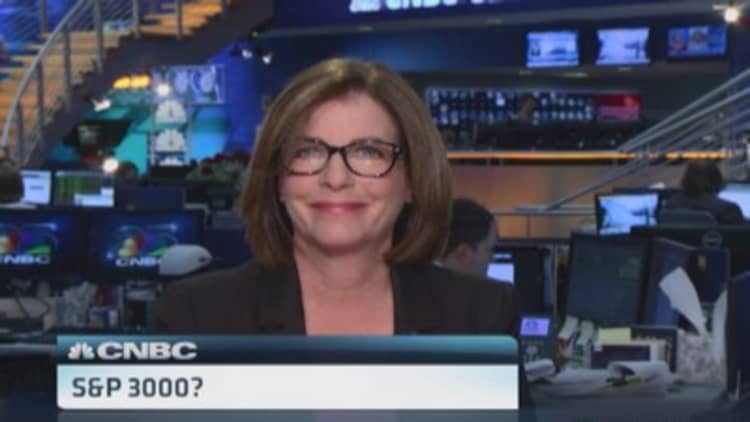With little homegrown action in the last days of August, Wall Street is trading on what it thinks might happen next month.
September starts with a bang the day after the Labor Day holiday, with August's jobs data looming at the end of next week. But a key to what's been working on markets in the last several days is Europe. The European Central Bank meets Sept. 4, and speculation is high that it will take further steps to ease policy after ECB President Mario Draghi hinted on policy action in a speech in Jackson Hole last Friday.
That has lifted European stocks, suppressed the euro and driven down sovereign yields. Short-end yields are now negative in five European countries. Meanwhile, U.S. stocks pushed higher Tuesday with the closing above 2,000 for the first time, following a seven-year high in consumer confidence and a durable goods number that was strong, though distorted by large aircraft orders. The durable goods report did add another 0.3 to tracking GDP, taking it to a median of 3.2 percent for the third quarter, according to a CNBC/Moody's Analytics snap survey.

Treasury yields moved higher at the long end in response to data, while buyers bid up the short end. While stocks have been rising, traders have been eyeing the long end of the curve, where yields have been close to year lows. That reversed somewhat Tuesday but the flattening trend continues, meaning short-end rates move closer to long-term rates.
The Treasury auctions $35 billion in 5-year notes and $13 billion in floating rate 2-year notes Wednesday. The auction of $29 billion in 2-year notes Tuesday was well received.
Read MoreWhy S&P 2,000 milestone has Art Cashin unimpressed
"Today it traded well, but it's the belly and short end that has come under pressure as the flattening has been traded over the last week, and as investors prepare for the potential of a Fed rate hike, said Justin Lederer, interest rate strategist at Cowen. "I think last week's FOMC minutes were definitely more hawkish than people expected, and Yellen was less dovish than expected." He said that cemented the view the Fed could raise rates in the middle of next year, as most Fed watchers expect.
As stocks have been rising, and bonds get pricier at the long end, some traders have been watching the 10-year as a possible warning for markets.
"The price action (in bonds) has been very consistent with some of the very technical aspects of the market—the month end needs in duration which are probably going to get exasperated by the reality that we are at these low yields because the majority of the (trading) community has been quiet and sidelined," said David Ader, chief Treasury strategist at CRT Capital.
"It forces people in and that has contributed to some of the strength over the last day or so. Today we had a very good 2-year auction, and I think this is a function in part of these negative yields."
Read MoreS&P takes flight again; Can US data keep it there?
Ader said recent buying in the long end could be related to several factors. "This is a lot about the international, and I think it's about a better deficit, and it may be a distrust of the stock market."
The declining yields in Europe have made Treasurys relatively attractive, but traders are watching the flattening of the yield curve. "Maybe most of it's the Fed. It could be the yield curve is telling us something—like the Fed is going to start hiking when the economy is not doing that much. It's a cautionary warning," Ader said, noting the spread between 2-year and 10-year yields is 189 basis points, the flattest since June 2013.
Read More Euro zone yields turn negative on Draghi hopes
Meanwhile, speculation about the ECB has been growing. JP Morgan economists in Europe said in a note that they expect easing from the ECB next week, and that it would likely take steps to make its long term refinancing operation more attractive. They expect the ECB to announce measures that would allow banks to lock in more funding for up to four years at a lower rate of 0.05 percent. The TLTRO launches in September, and JP Morgan economists say this would make it more appealing.
"In addition, we think Draghi will make a more definitive statement about what the ABS (asset-backed securities) purchase programme will look like. It is possible that the ECB goes beyond the current plan to buy ABS by purchasing other private assets, but we are not convinced of this," they said in a note. They also put the odds of the ECB buying sovereign bonds at 30 percent by the end of the year, and 50 percent next year.
Markets will also be watching mortgage application data at 7 a.m. ET, and U.S. government oil and gasoline inventory data at 10:30 a.m. ET. Earnings are expected from Brown-Forman, Tiffany, Express and Chico's FAS ahead of the open, and Williams-Sonoma reports after the market close.
Investors will also continue to monitor Ukraine. President Petro Poroshenko met with Russian President Vladimir Putin Tuesday. Putin said he will do what he can for peaceful solution for Ukraine, and he agreed to renew Ukraine energy talks. Poroshenko said a roadmap would be prepared to agree to a cease-fire.
—By CNBC's Patti Domm



